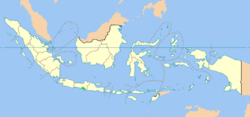Yogyakarta Special Region Daerah Istimewa Yogyakarta, or DIY) is a region of Indonesia. The city of Yogyakarta is the capital of the region. The 2010 census estimated its population at approximately 3,452,000.
Yogyakarta is historically and culturally part of the Central Java
region, although it is now a separate administrative entity. It is the
only region in Indonesia that is still governed by a pre-colonial
monarchy, the Sultan of Yogyakarta, who serves as the hereditary governor of the region. Excluding the special capital territory of Jakarta, it is the smallest region of Indonesia.
In Javanese it is pronounced [joɡjaˈkartɔ], and named after the city of Ayodhya in Javanese-Hindu mythology.
| Yogyakarta Special Region Daerah Istimewa Yogyakarta |
|||
|---|---|---|---|
| Parangtritis Beach, Yogyakarta | |||
|
|||
| Motto: Memayu Hayuning Bawana (Javanese) (The Vision to Perfect Society) written in Javanese Script |
|||
| Location of Yogyakarta Special Region in Indonesia | |||
| Coordinates: 7°47′S 110°22′ECoordinates: 7°47′S 110°22′E | |||
| Country | Indonesia | ||
| Capital | Yogyakarta | ||
| Government | |||
| • Sultan & Paku Alam | Sri Sultan Hamengkubuwono X, Sri Paku Alam IX | ||
| Area | |||
| • Total | 3,133.15 km2 (1,209.72 sq mi) | ||
| Population (2010 Census) | |||
| • Total | 3,452,390 | ||
| • Density | 1,100/km2 (2,900/sq mi) | ||
| Demographics | |||
| • Ethnic groups | Javanese (96,82%), Sundanese (0,56%), Chinese (0,32%) [1] | ||
| • Religion | Islam (91.4%), Christianity (8.3%), Hinduism and Buddhism (0.3%)[2] | ||
| • Languages | Javanese (Official), Indonesian (official), Bahasa Walikan Jogja, English in Javanese Dialects, Indonesian in Javanese Dialects | ||
| Time zone | WIB (UTC+7) | ||
| Website | www.pemda-diy.go.id | ||
History
Yogyakarta's support was essential in the Indonesian struggle for independence during the Indonesian National Revolution (1945-1949). The city of Yogyakarta became the capital of the Indonesian Republic from January 1946 to December 1948 after the fall of Jakarta to the Dutch. Later, the Dutch also invaded Yogyakarta causing the Indonesian Republic's capital to be transferred again to Bukittinggi in West Sumatra on 19 December 1948. In return for Yogyakarta's support, the declaration of Special Authority over Yogyakarta was granted in full in 1950 and the region became its own region. Because of its significant contribution for the survival of the Indonesian Republic, Yogyakarta was given the status as Special Administrative Region, making Yogyakarta the only region headed by a monarchy in Indonesia.
The Special Region was struck by a 6.3-magnitude earthquake on 27 May 2006. It killed 5,782 people and injured approximately 36,000. 600,000 people were left homeless.[4] The region of Bantul suffered the most damage and deaths.
| Historical population | ||
|---|---|---|
| Year | Pop. | ±% |
| 1971 | 2,489,360 | — |
| 1980 | 2,750,813 | +10.5% |
| 1990 | 2,913,054 | +5.9% |
| 1995 | 2,916,779 | +0.1% |
| 2000 | 3,122,268 | +7.0% |
| 2010 | 3,457,491 | +10.7% |
| Source: Badan Pusat Statistik 2010 | ||
Geography
The Special Region is located near the southern coast of Java, wholly within the province of Central Java. The population at the 2010 Census was 3,452,390. It has an area of 3,133.15 km2, making it the second-smallest area of the provinces in Indonesia, after the Jakarta Capital Region. Along with surrounding areas in Central Java, it has some of the highest population densities of Java.Mount Merapi is located to the immediate north of the city of Yogyakarta and Sleman Regency. It is the most active volcano in Indonesia and has erupted regularly since 1548. It last erupted in October–November 2010, killing and injuring many people and temporarily displacing approximately 100,000 residents.[5][6]
Administrative divisions
Yogyakarta Special Region (province-level) is subdivided into four regencies (kabupaten) and one city (kota):| Name | Capital | Area (km²) | Population 2000 Census |
Population 2005 estimate |
Population 2010 Census |
|---|---|---|---|---|---|
| Bantul Regency | Bantul | 506.86 | 781,000 | 859,968 | 910,572 |
| Gunung Kidul Regency | Wonosari | 1,485.36 | 670,400 | 681,554 | 674,408 |
| Kulon Progo Regency | Wates | 586.30 | 371,000 | 373,757 | 388,755 |
| Sleman Regency | Sleman | 574.80 | 901,400 | 988,277 | 1,090,567 |
| Yogyakarta City | Yogyakarta City | 32.50 | 396,700 | 433,539 | 388,088 |
| Totals | 3,133.15 | 3,121,045 | 3,337,095 | 3,452,390 |
Transport
Yogyakarta is served by Adisucipto International Airport. There are two train stations: Lempuyangan and Yogyakarta (also called Tugu station). Yogyakarta is considered one of the major hubs that links the west-east main railway route in Java island. To the south, in the Bantul region, is the Giwangan bus station, the largest bus station in Indonesia. The centre of metropolitan Yogyakarta is surrounded by a ring road.Since 2008, Yogyakarta Special Region launched bus rapid transit system, the Trans Jogja, which connects many places in and around Yogyakarta city, including the airport and Prambanan temple.[7]
Education
The Special Region is also the home of the first-established private university in Indonesia, the Islamic University of Indonesia, which was founded in 1945. The Indonesia Institute of Arts, the first-established university in fine arts, is also in the region.. Other large universities include Gadjah Mada University, Institute of Science & Technology AKPRIND in Yogyakarta, University of Sarjanawiyata Tamansiswa in Yogyakarta, Yogyakarta State University, Muhammadiyah University of Yogyakarta and Atma Jaya University in Yogyakarta.









0 komentar:
Posting Komentar